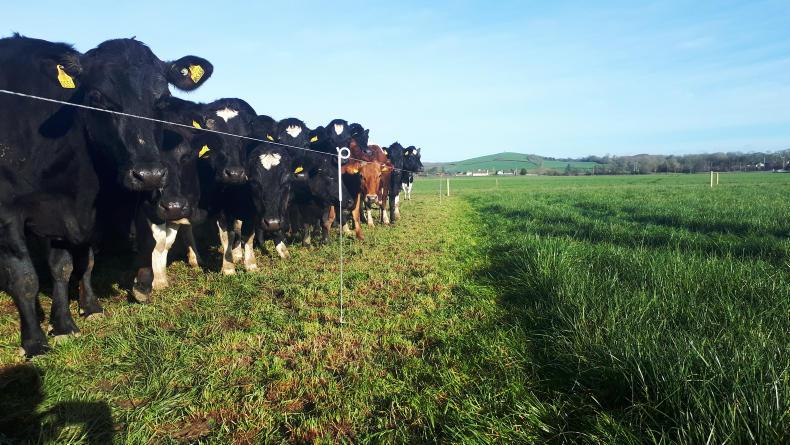While the rain has returned, it will take a lot of rain to upset grazing on a dry farm like Kilkenny. There are some very heavy covers of grass and David still has the two groups of dry cows grazing around the farm in blocks.
In the last week, they were peeling off the grass which is still relatively good-quality despite the fact that there are covers of 2,000kg plus. Getting the dry cows out has helped reached target for area grazed.
Average farm cover was 1,396kg at the last measuring with a growth rate of 20kg per day and even with 100 odd dry cows out the demand is still only 24kg per day.
Grazing
On Thursday, 28.5% of the farm was grazed. On Friday morning, a second round of urea was blanket-spread (40 units/acre) on some of the farm area. Some of the grazed paddocks didn’t get urea and they will get slurry in the coming days.
Given that fresh calvers are coming in and out, it’s hard to get a good measure on yield per cow. However, David estimates yield is about 17.4 litres per cow at 5.81% fat and 3.83% protein (1.73kg MS).
Cows are on nice-quality grass and 3kg of meal of a 16% protein nut in the parlour.
Animal health is going well overall. David says calf mortality including all stillborns is running around 6.6%.

Milking cows on Friday 1 March, Greenfield Kilkenny.
There have been a few cases of milk fever (six to eight approximately) and David reckons they have assisted about 10 calvings since the start of calving.
There is a good team on the farm which makes the workload possible. The core are David, Niall and Joe and the additional seasonal help is Niamh (WIT student) and James (night calver – 8pm to 6am). The night calving role will finish up soon as calving slows right down.
The period from the end of February into the start of March has certainly been a lot easier to manage than the same time in 2018.
Read more
Greenfield Farm: maximising February opportunities
While the rain has returned, it will take a lot of rain to upset grazing on a dry farm like Kilkenny. There are some very heavy covers of grass and David still has the two groups of dry cows grazing around the farm in blocks.
In the last week, they were peeling off the grass which is still relatively good-quality despite the fact that there are covers of 2,000kg plus. Getting the dry cows out has helped reached target for area grazed.
Average farm cover was 1,396kg at the last measuring with a growth rate of 20kg per day and even with 100 odd dry cows out the demand is still only 24kg per day.
Grazing
On Thursday, 28.5% of the farm was grazed. On Friday morning, a second round of urea was blanket-spread (40 units/acre) on some of the farm area. Some of the grazed paddocks didn’t get urea and they will get slurry in the coming days.
Given that fresh calvers are coming in and out, it’s hard to get a good measure on yield per cow. However, David estimates yield is about 17.4 litres per cow at 5.81% fat and 3.83% protein (1.73kg MS).
Cows are on nice-quality grass and 3kg of meal of a 16% protein nut in the parlour.
Animal health is going well overall. David says calf mortality including all stillborns is running around 6.6%.

Milking cows on Friday 1 March, Greenfield Kilkenny.
There have been a few cases of milk fever (six to eight approximately) and David reckons they have assisted about 10 calvings since the start of calving.
There is a good team on the farm which makes the workload possible. The core are David, Niall and Joe and the additional seasonal help is Niamh (WIT student) and James (night calver – 8pm to 6am). The night calving role will finish up soon as calving slows right down.
The period from the end of February into the start of March has certainly been a lot easier to manage than the same time in 2018.
Read more
Greenfield Farm: maximising February opportunities







 This is a subscriber-only article
This is a subscriber-only article








SHARING OPTIONS: